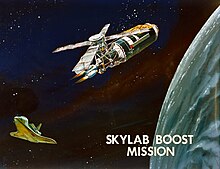

This article needs additional citations for verification. Please help improve this articlebyadding citations to reliable sources. Unsourced material may be challenged and removed.
Find sources: "Teleoperator Retrieval System" – news · newspapers · books · scholar · JSTOR (January 2014) (Learn how and when to remove this message) |



The Teleoperator Retrieval System was an uncrewed space tug ordered by NASA in the late 1970s to re-boost Skylab using the Space Shuttle.[1]
TRS was a design for an uncrewed robotic space tug designed to be capable of remote payload observation and boosting or de-orbiting another spacecraft. It was developed to potentially re-boost the Skylab space station to a higher orbit.[2] After Skylab 4, the third crewed mission to Skylab, plans were made to boost the station into a higher orbit to extend its service life or to de-orbit it into a remote ocean area.[3] A remotely controlled booster rocket was to be carried up in the Space Shuttle's third mission. Astronaut Jack R. Lousma described the remote booster as "as big as a truck" and requiring a control system able to match the circular motion of the Skylab docking port.[4] The core of TRS was a propulsion system that could accommodate additional fuel modules. It had a 24 nozzle 6-axis control thruster system to support Space rendezvous, docking, and orienting the spacecraft.[2]
Other options for launching TRS were Titan IIIorAtlas Agena. Some launch options might have required two launches. Martin Marietta proposed the Titan III for launching TRS.[5] The Titan IIIC could carry 29,600 lbs to low Earth orbit.[6]
The TRS was ordered in October 1977 to be ready for use in late 1979. The TRS had two major possible uses, to either re-boost or de-orbit Skylab. The decision whether to use TRS was planned to be made in 1979.[2]
Although TRS was initiated in 1977, it made use of developments in tele-operation going back to the 1960s. In addition, another reason for its selection was the long-term use for task in general including "payload survey, stabilization, retrieval and delivery missions, recovery and re-use capability.."[2]
The TRS project was overseen by the NASA Marshall Spaceflight Center.[2]
Because of delays in STS-1, the first shuttle launch, Lousma and Fred Haise were reassigned to the second shuttle mission.[7] NASA expected that the Shuttle would be ready by 1979, and Skylab would not re-enter until the early 1980s. Another factor was that, in 1975, it was decided not to launch a second Skylab (Skylab B); this gave a boost to Skylab re-use plans. As it was, the Shuttle was not ready until the early 1980s, and Skylab's orbit decayed in 1979.[5] Lousma and Haise's mission was canceled when NASA realized that STS-1 would not be early enough before the station's reentry.[7]
Although the TRS in development was focused on Skylab boosting, it was thought it could be used for other satellites.[8]
Possible future missions:[2]
Parts of the core, a box-like structure at center:[2]
The core was surrounded by four strap-on propulsion modules, which include an additional propellant tank with its own rocket engines.[2]
There was a triple group of attitude (direction) thrusters on each of the spacecraft's eight corners.[2] Each thruster was intended to produce a thrust of 2.25 to 4.5-kilograms (5 to 10-pounds) [2] These thrusters would be used for leaving the Shuttle's payload bay and for rendezvous and docking with Skylab.[2]
For the Skylab boost or de-orbit, the TRS would have four strap-on boosters each with 680 kg (1,500 Ib.) of hydrazine rocket fuel.[2] This was a modular design, and the TRS could also be used with 2-strap on boosters if the mission, if it only needed that amount.[2] In other words, the TRS was designed for use with 4 boosters, but it was also intended it could also use 2 for example.[2]

The TRS had its own computing and control systems, or it would be controlled by a crewman in the Shuttle Orbiter vehicle.[8]
|
| |||||||
|---|---|---|---|---|---|---|---|
| Flights |
| ||||||
| Astronauts |
| ||||||
| Contingencies |
| ||||||
| People |
| ||||||
| Related |
| ||||||